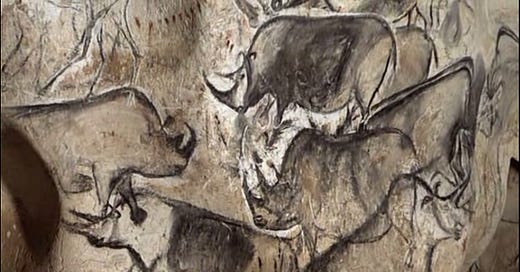Contrary to popular belief, and folk lore fed by promotional messaging, Scrum wasn’t invented by Jeff Sutherland and Ken Schwaber in 1995. Nor was it invented by Hirotaka Takeuchi and Ikujiro Nonaka in 1986 (although the latter pair were the first on record to use the rugby scrum metaphor for the creation of new products). Indeed, Scrum wasn’t ‘invented’ at all, only unearthed—which raises the interesting question: who buried it?
We’d need to go back in time, perhaps as far as the very the dawn of civilisation, some seven to eight thousand years ago to find an inventor—much further if we consider cave art to be a sign of civilisation—and even then (should we know how to look) we wouldn’t find one, but several thousand experimenters across the land, figuring out the best ways to make tools, clothes, cooking utensils, or decorative objects, or to learn how to hunt and gather in a new territory. Observing their process we’d see Scrum: identification of a problem, or need; a lightweight plan; a try/fail/try-again making process, using feedback to improve; the completion of something usable; and finally a reflection to consider what to do differently next time. This is our pattern for creative making. It is an abstract pattern in that can be applied to the creation of any new product, system or service. It does not apply to the manufacture of identical products; for that, turn to the world of Lean.
Humans, as a species, have always been craftworkers, inventors, makers of things. We are really good at it (so good in fact that we have learned to make things that will ultimately wipe out our entire species, but that’s another story.) For centuries then, this is how our stuff was made. Today it is still how new products are created, including prototypes for manufacturable products, and blueprints for engineered constructions, in short new product development (but not necessarily product creation). To put it another way, most new products, physical things, must be designed and then later made; the creative making pattern is used only for the first part, not the second.
The interesting thing about software is…well, that it is soft. It is malleable. We can design as we make and change our minds about the design, or the making (or both) at any times, and we can delete and remake at will. This makes software development products unique, and perhaps the only class of product that never needs to be manufactured to be distributed, to be useful.
The single mistake the corporate world made, when computers became a viable option for problem solving, was to think that making software products was like manufacturing, or like engineering, or some hybrid of the two. It is like neither. These are the wrong metaphors. When engineering, we need a design phase followed by a making phase. They are separate. Software development has no phases, design and making can (and ought to) happen simultaneously. When manufacturing we are finding ways to develop the fastest, most efficient way to mass-produce millions of identical widgets. Each software product is unique; reproduction is therefore unnecessary.
Creating new software products is a craft, and every product we craft is bespoke. Why did we not see this from the start? My guess is that we were still trapped in the Tayloresque frame of mind, a hang-over from the industrial revolution, where everything new was first engineered and then manufactured. We had white collar and blue collar workers, the former to do the thinking, the latter to do the manual labour.
But software development is knowledge work. Everyone must think. It is no longer useful to separate thinking and doing. Our single mistake propagated this mindset, insulting and oppressing generations of makers, and producing low quality, overly-complicated, often pointless products, that few wanted to use. The term “shelfware” was coined in the 1990s to describe such products.
Happily, people like the seventeen who wrote the manifesto for agile software development—but many more besides, going back to people like Tom Gilb in the 1970s, and no doubt others even earlier—took a stand against this Tayloresque hangover and began to challenge the status quo. Without realising they were doing so, they collectively recreated the creative making pattern developed by craftworkers so many thousands of years earlier, and still actively in practice in the majority of environments where people are creating (both through request and offer) new products for others, e.g. tailor-made clothes, shoes and hats, home improvements, custom-built furniture, artworks, landscapes, even restaurant meals.
To their credit, Jeff Sutherland and Ken Schwaber formalised the creative making process, making it palatable to executive corporate management, proving rhythm and clear boundary conditions, and introducing the scrum master, the only element of the framework not apparent in previous creative making manifestations. I’ll write about the necessity of the scrum master in a follow up post.
So for those of you who dismiss Scrum, based on the shaky reasoning that Scrum is too rigid, or that Scrum doesn’t tell you how to do Scrum, think carefully about what you are throwing away.
—




